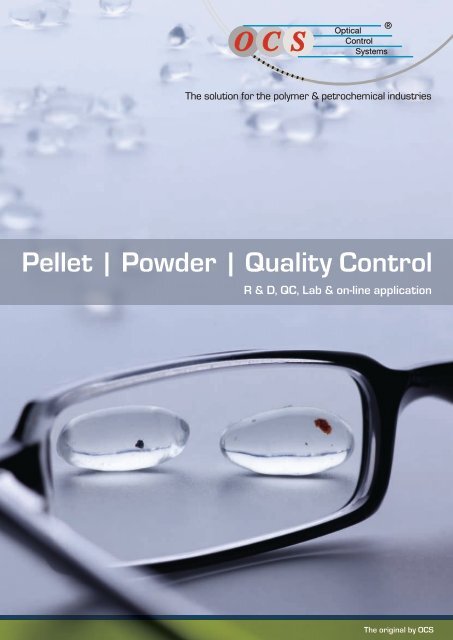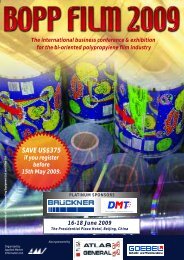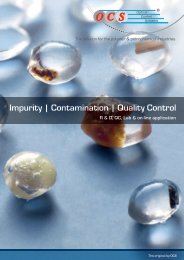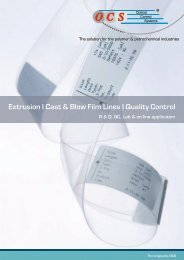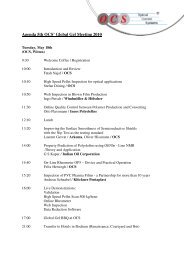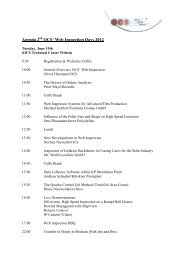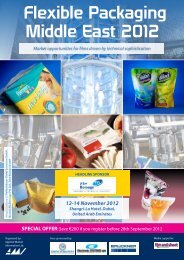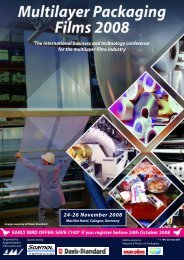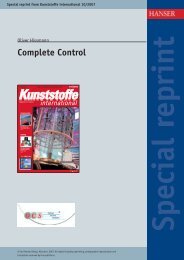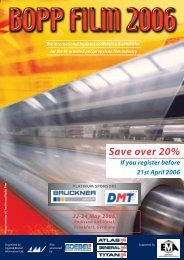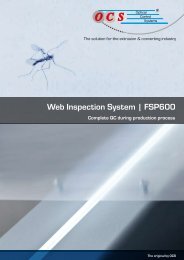Pellet | Powder | Quality Control - Optical Control Systems GmbH
Pellet | Powder | Quality Control - Optical Control Systems GmbH
Pellet | Powder | Quality Control - Optical Control Systems GmbH
You also want an ePaper? Increase the reach of your titles
YUMPU automatically turns print PDFs into web optimized ePapers that Google loves.
The solution for the polymer & petrochemical industries<br />
<strong>Pellet</strong> | <strong>Powder</strong> | <strong>Quality</strong> <strong>Control</strong><br />
R & D, QC, Lab & on-line application<br />
The original by OCS
High Speed <strong>Pellet</strong> Scanning <strong>Systems</strong><br />
PS200C<br />
The PS200C inspection system is used to analyse<br />
transparent and opaque pellets. The pellets are<br />
inspected with a high-resolution 3-CCD-chip matrix<br />
colour camera for impurities, foreign bodies, or<br />
colour deviations. The testing material is fed into<br />
the appliance through a hopper. Feeding can be<br />
automated by means of an online hopper. The<br />
pellets are distributed as one layer before approaching<br />
the inspection zone. After the optical<br />
evaluation the contaminated pellets can be separated<br />
into a different container (sorting unit<br />
option).<br />
Measuring errors are eliminated by use of numerous<br />
additional optical components. There is no<br />
colour dependency as with many other optoelectronic<br />
appliances. A high level of efficiency is<br />
achieved by powerful image processing software.<br />
The synchronisation of the transport system with<br />
the image processing offers a major contribution<br />
to the reproducibility of the measurement results.<br />
Installation in the bypass guarantees production<br />
monitoring and rapid reaction to any occurrences.<br />
The system provides a variety of individual configurations,<br />
which guarantees an improved adaptation<br />
to specific requirements.<br />
The measurement data are stored in a test report<br />
to enable future analysis. The recorded images<br />
and measured data can be observed on a screen<br />
during the measuring process. The results can be<br />
shown and printed in tables or graphs.<br />
Along with a pure inspection of pellets the system<br />
can also be used to record, file and document.<br />
Each defined deviation is recorded in the measurement<br />
protocol via a multidimensional characteristics<br />
vector with an error map.<br />
The system can be adapted exactly to the respective<br />
requirements with the help of the extensive<br />
software packages.
Performance Characteristics<br />
• Modular architecture<br />
Easy to extend, simple, adaptation and<br />
upgrade<br />
• <strong>Control</strong>s<br />
Menu-controlled windows interface and easy<br />
customisation<br />
• Optimum lighting technology<br />
Use of special lighting technology, therefore<br />
independent of the material<br />
• Real-time colour image analysis<br />
Fast evaluation and representation of the<br />
measurement results in various forms. Table<br />
with size classifications, time evolution,<br />
mosaic view, histogram, distribution<br />
• Inspection synchronisation<br />
Transport unit, inspection unit and sorting<br />
unit (optional) are coordinated exactly to<br />
each other<br />
• Sorting device<br />
Sorting and separate collection of<br />
contaminated pellets<br />
• Tables<br />
Tabular display according to size, shape and<br />
colour<br />
• Mosaic display<br />
Continuous display of the defected deviations<br />
as real images<br />
• Features graphics<br />
Graph of the distribution over sizes, shapes<br />
and colours<br />
• Time characteristics<br />
Graph of the distribution of the characteristics<br />
according to time evolution<br />
• Process synchronisation<br />
Coupling the inspection system with external<br />
appliances, e.g. MODBUS<br />
• Interfaces for external appliances<br />
Alarm interface and analogue scales<br />
• Open database<br />
The recorded data can be converted into all<br />
standard file formats (BMP, JPEG, WMF,<br />
EMF, PDF, CSV)
Technical Data<br />
• Camera<br />
3-CCD-chip colour matrix camera<br />
• Lighting<br />
High frequency synchronised fluorescent<br />
lamp white light spectrum;<br />
Power consumption: 8 lamps each 18 W<br />
• Computer<br />
Industrial Intel®Core 2 Duo<br />
Up-to-date technology<br />
• Software<br />
Operating system Windows XP<br />
Special Image Processing<br />
• Physical interfaces<br />
Ethernet 10/100 M Base T, USB, RS 485,<br />
RS 232, digital & analogue I/0, Fieldbus<br />
• Communication protocol<br />
MODBUS RTU, MODBUS TCP/IP, OPC, SQL,<br />
file transfer (customised), PROFIBUS<br />
Implementation to other Fieldbus-<strong>Systems</strong><br />
possible<br />
• Remote control<br />
Extender max. 100 m<br />
Service remote control<br />
• Size dimension<br />
(l, w, h) 770 x 770 x 650 mm<br />
Weight approx. 100 kg<br />
• Power supply<br />
230 V AC/115V AC, 50/60 Hz<br />
• Temperature<br />
10 – 40 °C<br />
• Instrument air: 6 bar<br />
Technical alterations are reserved
PS400C<br />
The PS400C inspection system is used to analyse<br />
transparent and opaque pellets. The pellets are<br />
inspected with multiple high-resolution 3-CCD-chip<br />
line colour cameras for impurities, foreign bodies,<br />
or colour deviations. The pellets are inspected in<br />
the free fall (further description as the PS200C).<br />
An additional feature for the PS400C is the determination<br />
of the mixing ratio of different coloured<br />
pellets, which is an essential feature for compounder<br />
& masterbatch manufacturer.
Purpose<br />
• Contamination detection<br />
• Contamination sorting (optional)<br />
• Concentration measuring of mixed product<br />
Setup<br />
• Expandable modular concept<br />
• Material dosage by vibration feeder<br />
• Material acceleration by belt<br />
• Scanning in free fall<br />
• Colour line scan camera (scanning front<br />
side of pellet stream)<br />
• Optional second colour line scan camera<br />
(scanning back side of pellet stream) for<br />
non-transparent pellets<br />
• Throughput up to 400 kg/h (per base unit)<br />
• Resolution 100 µm (others on request)<br />
• Scan width 180 mm<br />
• Optional sorter with 18 lanes<br />
• Scalable (1 Server, up to 5 PS400C-Clients)<br />
• Especially designed for highly transparent<br />
pellets<br />
Technical Data<br />
Camera<br />
• 3-CCD-chip line scan camera<br />
• Special lenses optimised for camera prism<br />
• Max. line frequency 19,047 kHz<br />
• Max. data rate 40 MB/s<br />
• S/N ratio > 58 dB<br />
• Power consumption: 13,2 W<br />
• Automatic shading correction<br />
• Automatic white balancing
Lighting<br />
• PLC controlled<br />
• Power supply 230 VAC/50 Hz<br />
• 28 fluorescence lamps each 18 W<br />
• Automatic brightness control<br />
Material Feeding<br />
• PLC controlled<br />
• Conveyor belt<br />
• Vibration feeder<br />
Applications for PS200C & PS400C<br />
• Opaque pellets<br />
• Coloured pellets<br />
• Transparent pellets<br />
• Material throughput up to 200 kg/h<br />
(PS 200C)<br />
• Material throughput up to 400 kg/h<br />
(PS 400C)
Contamination Detection<br />
with PS25C<br />
The PS25C inspection system is used to analyse<br />
transparent and opaque pellets. The pellets are<br />
inspected with a high-resolution 3-CCD-chip colour<br />
camera for impurities, foreign bodies, or colour<br />
deviations.<br />
The testing material is fed into the appliance<br />
through a hopper. Feeding can be automated by<br />
means of an extension module, e.g. a multi-hopper<br />
system or an online hopper.<br />
Moreover, an accurate colour measurement in a<br />
special measurement chamber can be carried out<br />
by means of colour spectrometry CM2 (option).<br />
The pellets are conveyed as one layer over the<br />
inspection zone via a vibrating channel. After the<br />
optical evaluation the contaminated pellets can be<br />
separated into a different container (sorting unit<br />
option).<br />
Measuring errors are eliminated by use of numerous<br />
additional optical components. There is no<br />
colour dependency as with many other optoelectronic<br />
appliances.<br />
A high level of efficiency is achieved by powerful<br />
image processing software. The synchronisation<br />
of the transport system with the image processing<br />
offers a major contribution to the reproducibility of<br />
the measurement results.<br />
Optimum adaptation in laboratory operations or in<br />
measuring stations is a paramount factor in the<br />
quality control. Installation in the bypass guarantees<br />
production monitoring and rapid reaction to<br />
any occurrences. The system provides a variety<br />
of individual configurations, which guarantees an<br />
improved adaptation to specific requirements.<br />
The measuring is stored in a test report to enable<br />
future analysis. The recorded images and<br />
measured data can be observed on a screen during<br />
the measuring process. The results can be shown<br />
and printed in tables or graphs.<br />
Along with a pure inspection of pellets the system<br />
can also be used to record, file and document.<br />
Each defined deviation is recorded in the measurement<br />
protocol via a multidimensional characteristics<br />
vector with an error map.<br />
The system can be adapted exactly to the respective<br />
requirements with the help of the extensive<br />
software packages.
Performance Characteristics<br />
• Modular architecture<br />
Easy to extend, simple, adaptation and<br />
ugrade<br />
• <strong>Control</strong>s<br />
Menu-controlled Windows interface and easy<br />
customisation<br />
• Optimum lighting technology<br />
Use of special lighting technology, therefore<br />
independent of the material<br />
UV-Lighting (option), for inspection of<br />
fluorescent pellets<br />
• Real-time colour image analysis<br />
Fast evaluation and representation of the<br />
measurement results in various forms<br />
Table with size classifications, time evolution,<br />
mosaic view, histogram, distribution<br />
• Inspection synchronisation<br />
Transport unit, inspection unit and sorting<br />
unit (optional) are co-ordinated exactly to<br />
each other<br />
• Sorting device<br />
Sorting and separate collection of<br />
contaminated pellets<br />
• Tables<br />
Tabular display according to size, shape and<br />
colour<br />
• Mosaic display<br />
Continuous display of the detected deviations<br />
as real images<br />
• Features graphics<br />
Graph of the distribution over sizes, shapes<br />
and colours<br />
• Time characteristics<br />
Graph of the distribution of the characteristics<br />
according to time evolution<br />
• Process synchronisation<br />
Coupling the inspection system with external<br />
appliances, e.g. MODBUS interface<br />
• Interfaces for external appliances<br />
Alarm interface, analogue scales, multihopper<br />
system, spectrometry, PSSD (PA66)<br />
• Open database<br />
The record data can be converted into all<br />
standard file formats (BMP, JPEG, WMF, EMF,<br />
PDF, CSV)
Technical Data<br />
• Camera<br />
3-CCD-chip colour matrix camera<br />
• Lighting<br />
High frequency synchronised fluorescent<br />
lamp white light spectrum;<br />
Power consumption: 22 W<br />
• Computer<br />
Industrial Intel®Core 2 Duo<br />
Up-to-date technology<br />
• Software<br />
Operating system Windows XP<br />
Special Image Processing<br />
• Physical interfaces<br />
Ethernet 10/100 M Base T, USB, RS 485,<br />
RS 232, digital & analogue I/0, Fieldbus<br />
• Communication protocol<br />
MODBUS RTU, MODBUS TCP/IP, OPC, SQL,<br />
file transfer (customised), PROFIBUS<br />
Implementation to other Fieldbus-<strong>Systems</strong><br />
possible<br />
• Remote control<br />
Extender max. 100 m<br />
Service remote control<br />
• Size dimension<br />
(l, w, h) 50 x 50 x 50 cm<br />
Weight approx. 30 kg<br />
• Power supply<br />
230 V AC/115V AC, 50/60 Hz<br />
• Temperature<br />
10 – 40 °C<br />
• Instrument air: 6 bar
Contamination<br />
Detection with PT2C<br />
The <strong>Powder</strong> Testing System PT2C, equipped with<br />
a 3-CCD-chip colour camera, counts and classifies<br />
contaminations. Colour classes can be defined<br />
with the »teaching« tool to detect discolorations<br />
and foreign bodies which are different in colour<br />
from the bulk material, such as PVC, PP, PE, Salt etc.<br />
The system is capable of detecting contamination<br />
and discoloured powder particles (pink, yellow,<br />
brown, black etc.). These irregularities are sorted<br />
into different class sizes which are completely<br />
user definable. Furthermore, it is possible to define<br />
alarm limits. If these are exceeded, a potential-free<br />
contact is activated.<br />
The PT2C can be used for laboratory purposes<br />
as well as for on-line inspection. The powder can<br />
be submitted as a sample or it can be withdrawn<br />
from the production line by creating a bypass.<br />
Using a bypass system gives the user the advantage<br />
of direct inspection of the material during the<br />
production process. This allows faster response<br />
in order to prevent off spec production.<br />
The software offers a multitude of configuration<br />
possibilities, enabling the user to adapt the system<br />
exactly to individual requirements.<br />
The inspection can be observed on a monitor<br />
and visible defects marked and indexed. Images<br />
of special importance can be stored and the data<br />
presented in a variety of graphs and tables. A colour<br />
printer documents the results. Configuration data,<br />
software settings and duration of the inspection<br />
can be easily accessed. This facilitates later or<br />
long-term evaluation.<br />
The <strong>Powder</strong> Testing System PT2C has a rated<br />
capability of inspecting up to 1 kg/hour. The<br />
actual throughput is dependent on the physical<br />
characteristics of the powder. The system can be<br />
integrated in any internal data processing system<br />
using an existing software interface, e.g. Ethernet.<br />
The unit is robust and maintenance-friendly.
Performance Characteristics<br />
• <strong>Control</strong>s<br />
Menu-controlled Windows interface and easy<br />
customisation<br />
• Optimum lighting technology<br />
Use of special lighting technology, therefore<br />
independent of the material<br />
• Real-time colour image analysis<br />
Fast evaluation and representation of the<br />
measurement results in various forms<br />
Table with size classifications, time evolution,<br />
mosaic view, histogram, distribution<br />
• Inspection synchronisation<br />
Transport and inspection are co-ordinated<br />
exactly to each other<br />
• Tables<br />
Tabular display according to size, shape and<br />
colour<br />
• Mosaic display<br />
Continuous display of the detected deviations<br />
as real images<br />
• Features graphics<br />
Graph of the distribution over sizes, shapes<br />
and colours<br />
• Time characteristics<br />
Graph of the distribution of the characteristics<br />
according to time evolution<br />
• Process synchronisation<br />
Coupling the inspection system with external<br />
appliances<br />
• Interfaces for external appliances<br />
Alarm interface, multi-hopper system, sorter<br />
system<br />
• Open database<br />
The record data can be converted into all<br />
standard file formats (BMP, JPEG, WMF,<br />
EMF, PDF, CSV)
Technical Data<br />
• Camera<br />
3-CCD-chip colour matrix camera<br />
• Lighting<br />
High frequency synchronised fluorescent<br />
lamp white light spectrum;<br />
Power consumption: 18 W<br />
• Computer<br />
Industrial Intel®Core 2 Duo<br />
Up-to-date technology<br />
• Software<br />
Operating system Windows XP<br />
Special Image Processing<br />
• Physical interfaces<br />
Ethernet 10/100 M Base T, USB, RS 485,<br />
RS 232, digital & analogue I/0, Fieldbus<br />
• Communication protocol<br />
MODBUS RTU, MODBUS TCP/IP, OPC, SQL,<br />
file transfer (customised), PROFIBUS<br />
Implementation to other Fieldbus-<strong>Systems</strong><br />
possible<br />
• Remote control<br />
Extender max. 100 m<br />
Service remote control<br />
• Size dimension<br />
(l,w,h) 50 x 50 x 50 cm<br />
Weight approx. 30 kg<br />
• Power supply<br />
230V AC/115V AC, 50/60 Hz<br />
• Temperature<br />
10 – 40 °C
<strong>Pellet</strong> Size & Shape Distribution System PSSD<br />
The PSSD is a modular inspection system for the<br />
rapid analysis & classification of the size and shape<br />
of granules. The pellets which are to be inspected<br />
are moved by the vibrating table and are measured<br />
individually in the free fall between the camera<br />
and the light source. This universal measurement<br />
principle enables the system to analyse up<br />
to 50 kg granules per hour, depending on the<br />
granule size and it’s bulk density.<br />
The use of a high resolution CCD camera with<br />
automatic controllable lighting offers a continuous<br />
reproducibility of the measured results. This instrument<br />
can analyse granules and particles from<br />
70 µm upwards (20 µm option), independent of<br />
their colour.<br />
The optimal operation in a laboratory environment,<br />
as well as in an online measurement station is<br />
a paramount factor in the quality control. This<br />
instrument offers a huge variety of customised<br />
configurations to fit the customer’s needs and<br />
objectives perfectly. For example, when installed<br />
in a bypass of the production line, this system will<br />
allow for a fast response to production problems.<br />
The measured data are stored in a control protocol<br />
on the image processing computer to enable<br />
future analysis, and this data can be transferred<br />
to the control room. During the measurement<br />
process, the images and the stored data are<br />
displayed in real time on the monitor. The results<br />
can be shown in a table or in a graphic and can<br />
be printed as well.<br />
Not only can this instrument perform a precise<br />
analysis and classification of the granules, it can also<br />
be used for recording, archiving and documentation<br />
purposes. Each variation of the pellets shape, size,<br />
diameter, elongation, roundness, roughness and/<br />
or convexity will be recorded in the measurement<br />
protocol on a multidimensional characteristics<br />
vector with an error map.<br />
With this tailor-made and sophisticated software<br />
package, this instrument will perfectly fulfill all<br />
your needs!
Distribution cloud of different particles<br />
Performance Characteristics<br />
• Modular architecture<br />
Possibility of extension, easy adaptation and<br />
upgrade<br />
• Utilisation<br />
Windows interface and easy customisation<br />
• Optimal lighting techniques<br />
Use of a special lighting technique to avoid<br />
colour related troubles during the pellet<br />
analysis<br />
• Real-time image analysis<br />
Fast evaluation, analysis and representation<br />
of the measured results in different formats:<br />
table with size classifications, time evolution,<br />
mosaic view, histogram, distribution<br />
• Table view<br />
Results displayed in table according to the<br />
shape, size, diameter, elongation, roundness,<br />
roughness, and/or convexity<br />
• Mosaic view<br />
Continuous display in real picture of the<br />
variations<br />
• Graphic of the characteristics<br />
Graphical display of the repartition by size,<br />
shape, etc.<br />
• Time evolution<br />
Graphical display of the repartition of the<br />
characteristic according to the time<br />
evolution<br />
• Process synchronisation<br />
Interconnections between the inspection<br />
system and external instruments<br />
• Interface for external applications<br />
Alarm interface, digital balance, etc.<br />
• Open database<br />
The data from the protocol can be easily<br />
converted into the entire common database<br />
format (MS Access, Excel, etc.)
Technical Data<br />
• Camera<br />
CCD Line Scan Sensor 4096 Pixel<br />
160 MHz<br />
• Lighting<br />
High frequency synchronised fluorescent<br />
lamp white light spectrum;<br />
Power consumption: 32 W<br />
• Computer<br />
Industrial Intel®Core 2 Duo<br />
Up-to-date technology<br />
• Software<br />
Operating System Windows XP<br />
Special Image Processing<br />
• Physical interfaces<br />
Ethernet 10/100 M Base T, USB, RS 485,<br />
RS 232, digital & analogue I/0, Fieldbus<br />
• Communication protocol<br />
MODBUS RTU, MODBUS TCP/IP, OPC, SQL,<br />
file transfer (customised), PROFIBUS<br />
Implementation to other Fieldbus-<strong>Systems</strong><br />
possible<br />
• Remote control<br />
Extender max. 100 m<br />
Service remote control<br />
• Size dimension<br />
(l,w,h) 100 x 50 x 50 cm<br />
Weight approx. 60 kg<br />
• Throughput<br />
Up to 50 kg/h<br />
• Power supply<br />
230V AC/115V AC, 50/60 Hz<br />
• Temperature<br />
10 – 40°C<br />
Particle Size Distribution
<strong>Pellet</strong> Analyser PA66<br />
The product quality in the plastic processing industry<br />
demands that the raw material itself conforms to<br />
the necessary requirements with regard to purity,<br />
colour and property of the pellets.<br />
It is a red signal for the raw material producer if the<br />
pellets have coloured or black inclusions that are<br />
generated in the synthesising and/or pelletising<br />
section.<br />
It is just as critical if polymer dust and fines<br />
occur in the process that indicate non-optimal<br />
transport conditions in the area of loading/<br />
unloading trucks and bagging. However, if the fines<br />
were shown to have been created in the synthesising<br />
area, it would be the responsibility of the<br />
downstream cyclone classifying to create “fines”free<br />
pellets before delivery.<br />
Undesired loose impurities on the pellets are<br />
carried in, for example, through contaminated<br />
conveying air (filter) or in an unclean silo vehicle,<br />
and therefore manufacturer, transporters and<br />
end processor will be affected hereby. In this case<br />
it is essential to have accurate testing documentation<br />
available in order to monitor and eliminate<br />
the cause of the defects. Moreover, additional<br />
costs in further processing can be prevented.<br />
The constantly increasing production speeds<br />
in processing demand that the pellet quality<br />
complies with technical developments. Continuity<br />
with regard to a defined pellet size distribution is<br />
required, because at high loads the feed behaviour<br />
in the processing machines can react sensitively<br />
to even minor fluctuations of a more or less wide<br />
distribution. In this context, the pellet shape (e.g.<br />
lense/cylinder/dice/sphere) is equally important.<br />
Additional interference occurs in processing pellet<br />
mixtures if it has to be guaranteed that the<br />
composition remains stable in the processing (no<br />
segregation). The same applies to masterbatches<br />
or the subsequent metering of additives.<br />
The PELLET ANALYSER PA66 system complies<br />
with the precondition through the combination of<br />
the highly sensitive PSSD, PS25C and real colour<br />
measurement CM2 (option).<br />
Impurities are measured in the PS25C inspection<br />
system with the help of a 3-CCD-chip colour camera<br />
according to colours, sizes and shapes.<br />
High-performance evaluation software processes<br />
the raw data into extremely variable visual graphics<br />
and tables, and also into representations of the<br />
defects (mosaic display).<br />
As a modular inspection system the PSSD system<br />
counts and measures the size and shape of pellets.<br />
The pellet size and shape can be determined in<br />
10 different classes. The PSSD system also detects<br />
twins, triples, spikes and dog-bones as well as<br />
pellets with fines and tails. The system can indicate<br />
dust and tails proportion. By counting all measured<br />
pellets the pellet weight (pellets/g) can be determined,<br />
in combination with a weighing device.<br />
The colour measurement CM2 (option) determines<br />
the colours of the pellets on-line with a<br />
spectrometer and presents the data in various<br />
standards (e.g. L,a,b values).<br />
With a suitable layout the system can be operated<br />
both off-line and on-line.<br />
The time history for each production batch is documented<br />
and filed through the automatic storage of<br />
all measured data.
Colour Measurement System CM2<br />
The CM2 system serves the automatic colour<br />
measurement of plastic granules. The granules<br />
are carried in a special measuring channel.<br />
In the process it develops a granule column,<br />
which can be brought to the optimal measuring<br />
temperature through an air flush. In the measuring<br />
channel there is an opening which serves the<br />
measurement.<br />
A rotary feeder (optional) provides a continuous<br />
transport of the granules. A colour spectrometer<br />
records the colour spectrum of the granules<br />
through the instrumentation opening and determines<br />
the colour of the granules.<br />
Different colour displays or standards can be<br />
realised e.g. CIE-L,a,b/X,Y,Z as well as Yellowness<br />
Index. The data can be rounded up and assigned<br />
to a process control system.
Technical Data<br />
PS25C<br />
• Camera<br />
3-CCD-chip colour matrix camera<br />
• Lighting<br />
High frequency synchronised fluorescent<br />
lamp white light spectrum;<br />
Power consumption: 22 W<br />
PSSD<br />
• Camera<br />
CCD Line Scan Sensor<br />
• Lighting<br />
High frequency synchronised fluorescent<br />
lamp white light spectrum;<br />
Power consumption: 32 W<br />
• Computer<br />
Industrial Intel®Core 2 Duo<br />
Up-to-date technology<br />
• Software<br />
Operating system Windows XP<br />
Special Image Processing<br />
• Physical interfaces<br />
Ethernet 10/100 M Base T, USB, RS 485,<br />
RS 232, digital & analogue I/0, Fieldbus<br />
• Communication protocol<br />
MODBUS RTU, MODBUS TCP/IP, OPC, SQL,<br />
file transfer (customised), PROFIBUS<br />
Implementation to other Fieldbus-<strong>Systems</strong><br />
possible<br />
• Remote control<br />
Extender max. 100 m<br />
Service remote control<br />
• Size dimension<br />
(l,w,h) 120 x 50 x 170 cm<br />
Weight approx. 120 kg<br />
• Power supply<br />
230 V AC/115V AC, 50/60 Hz<br />
• Temperature<br />
10 – 40 °C
»Optimise your production<br />
through precise quality control«<br />
OCS
Return of Investment (ROI)<br />
<strong>Quality</strong> Increase by constancy, continuity, on-<br />
time re-adjusting, alarm settings, limitation values,<br />
fast reaction, remix/transition, general plant<br />
overview, error prevention, value-free judgement.<br />
Scrap/Sub-standard product minimising<br />
The plant performance is increased significantly,<br />
because of the direct insertion of influence.<br />
Furthermore parts of scrap/sub-standard can<br />
be re-used/re-mixed, because all parameters are<br />
under control permanently- the plant will be more<br />
efficient.<br />
Transition time reduction because all the<br />
analytical values are available permanently. This<br />
enables the operation team, to finish the transition<br />
much more earlier, instead of waiting for<br />
Lab results.<br />
Cost savings because of operation availability<br />
(stable process, no waiting time for analytical<br />
results), limited energy consumption, and<br />
maintenance in one hand (no multi maintenance<br />
contracts, spare parts promptly obtainable and<br />
experts available on short term).<br />
Optimising product sequences<br />
The process is well overseen, will be in control<br />
durably and the operation conditions can be changed<br />
very fast and flexible.<br />
ROMPETROL<br />
REPSOL<br />
SOLVAY<br />
GE PLASTICS<br />
SHELL<br />
TOTAL<br />
EASTMAN<br />
EXXONMOBIL<br />
ARYA SASOL<br />
Additionally<br />
• Accurate and continuous automatic<br />
analysis<br />
• 24 hour online production surveillance<br />
• Trend analysis parallel to production<br />
• Logging of the production process<br />
• Accurate and consistent automatic<br />
grading<br />
• Reduction of customer returns and<br />
complaints<br />
CHINA JINSHAN<br />
NOVA<br />
RÖHM & HAAS<br />
INEOS<br />
MITSUBISHI<br />
NEXANS<br />
LYONDELLBASELL<br />
DUPONT<br />
ARKEMA<br />
SABIC<br />
MITSUI<br />
BOROUGE<br />
BRASKEM<br />
DOW<br />
BASF<br />
BOREALIS<br />
CHINA PETROCHEMICAL<br />
CABOT<br />
CLARIANT<br />
QAPCO<br />
DSM<br />
JAPAN POLYETHYLENE<br />
TETRA PAK<br />
BAYER
<strong>Optical</strong> <strong>Control</strong> <strong>Systems</strong> <strong>GmbH</strong><br />
Wullener Feld 24<br />
58454 Witten<br />
Germany<br />
Fon +49 (2302) 95 622 – 0<br />
Fax +49 (2302) 95 622 – 33<br />
info@ocsgmbh.com<br />
www.ocsgmbh.com


